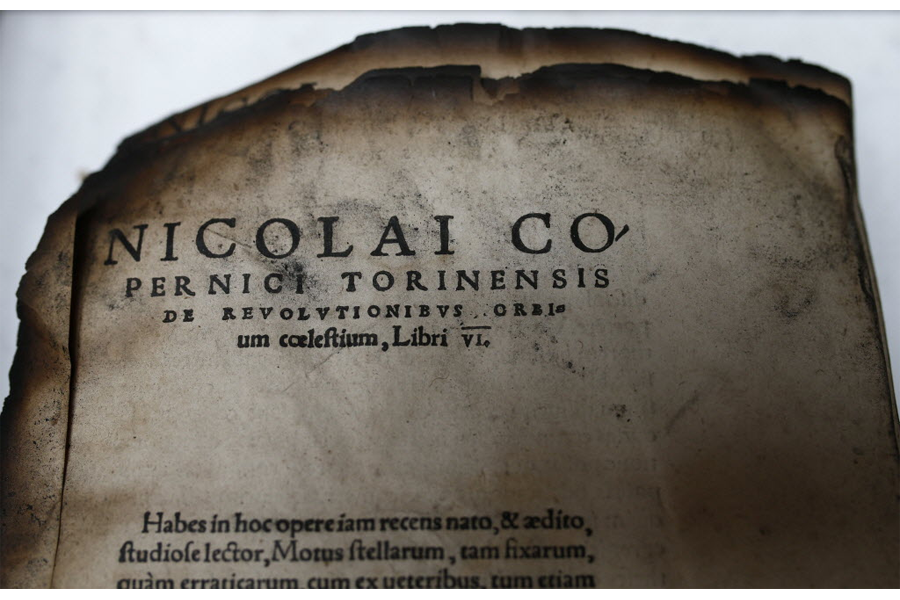Copernicus book believed to have been destroyed in a library fire is found after 10 years
Loading...
In 2004, the Duchess Anna Amalia Library in Weimar, Germany, housed one of the most important collections of books and manuscripts in the country, including "De Revolutionibus Orbium Coelestium, Libri VI" (1543), a work by famed Renaissance astronomer and mathematician Nicolaus Copernicus.
In that same year, the oldest part of the library went up in flames, destroying thousands of books. Copernicus' book was one of many believed lost.
Now, 10 years later, Copernicus' book has been found among the many damaged works still waiting to be restored.
The historical library building had been declared a UNESCO World Heritage Site in 1998, according to the library's official site. On Sept. 2, 2004, however, the building caught fire, destroying the top two floors completely. The bottom floors managed to largely escape damage from the fire.
Thousands of books weren't so lucky.
According to the Help for Anna Amalia website, the conflagration was the worst library fire Germany had seen since World War II, when a number of libraries were destroyed by fires sparked by Allied bombing runs. In all, 50,000 books at the Duchess Anna Amalia Library were lost, a quarter of which are considered irreplaceable. In addition, 37 historical oil paintings went up in flames.
The damage wasn't as bad as it could have been, however. On the night of the fire, 6,000 historical books and manuscripts were saved by passing them hand-over-hand outside the burning building. However, many of the books left inside were heavily damaged by water being pumped in to put out the fire and had to be immediately taken away and freeze-dried to prevent rotting. There were 62,000 books damaged by fire, water, or both.
According to German news outlet Deutsche Welle, the books were put into groups based on damage rather than content. The Copernicus volume, which contains mathematical proofs that the earth rotates around the sun and spins on its own axis, was in the fourth group of the most heavily damaged books. Groups No. 1 through No. 3 were restored first, which is why it took so long to be rediscovered by library officials.
Nicolaus Copernicus lived from 1473 to 1543. His "De Revolutionibus Orbium Coelestium" ("On the Revolution of the Celestial Spheres"), completed just before his death, is considered to be one of the most important works in the history of science. While he was not the first to theorize that the earth travels around the sun, he was the first to provide solid mathematical proof for the phenomenon, and his theories would become an important model on which later astronomers such as Galileo Galilei and Johannes Kepler would build.
A printing of the sixth part of this monumental work was the volume thought to have been lost in 2004.
According to DW, restoring the books and manuscripts that were damaged in the fire has been a long and expensive process. Some 38.8 million euros ($51.9 million) have been collected for the restoration of the books and the library so far and 20 million euros ($26.7 million) have already been spent. The library was able to re-open in 2007, but restoration of the books is expected to continue for the next 15 years.
Thirty-six thousand of the 62,000 books that need restoration have been repaired. The process is complex, expensive, and time-consuming; each page of a damaged book has to be individually washed, meshed with a new paper substance so it can be handled, and then dried. Often, this is only the beginning of an even longer process to restore the most damaged books.
Restoring such an important and prestigious collection should be worth the cost and effort, however. According to DW, one of the first overseers of the library was none other than Wolfgang von Goethe himself, the great German poet. Since the days of Goethe's leadership, the library has amassed an incredible collection that includes a Bible connected to Martin Luther, original musical manuscripts from the likes of Johann Sebastian Bach, ancient ancestral records, unique medieval manuscripts, and, of course, the newly rediscovered Copernicus masterpiece.
According to DW, the estimated worth of the "De Revolutionibus Orbium Coelestium, Libri VI," even in its damaged state, is about 1.4 million euros ($1.8 million). The feeling of finding such an important piece of history that was thought to be destroyed, of course, is priceless.
Weston Williams is a Monitor contributor.








